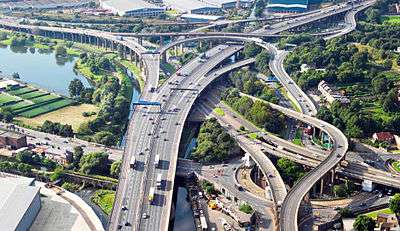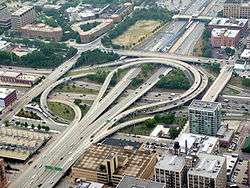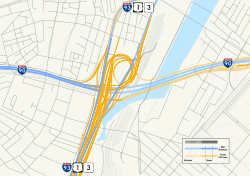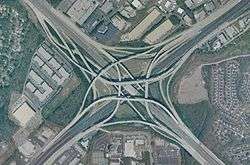Spaghetti junction
Spaghetti Junction is a nickname sometimes given to a complicated or massively intertwined road traffic interchange that is said to resemble a plate of spaghetti. Such interchanges may incorporate a variety of interchange design elements in order to maximize connectivity.

Etymology
The term was originally used to refer to the Gravelly Hill Interchange on the M6 motorway in Birmingham, United Kingdom.[1] In an article published in the Birmingham Evening Mail on 1 June 1965 the journalist Roy Smith described plans for the junction as "like a cross between a plate of spaghetti and an unsuccessful attempt at a Staffordshire knot", with the headline above the article on the newspaper's front page, written by sub-editor Alan Eaglesfield, reading "Spaghetti Junction".[2][3][4] Since then many complex interchanges around the world have acquired the nickname.
Throughout North America, this type of interchange is widely referred to as a spaghetti junction, mixing bowl, knot, or maze, often including the name of the freeway, city, or notable landmark near enough to the interchange.
Japan, somewhat colloquially, has adopted the term tentacle junction in lieu of the Western phrase.
By country
Australia
New South Wales
- Light Horse Interchange, at the junction of M7 Westlink Motorway & M4 Western Motorway in Eastern Creek, Sydney.
Queensland
- The interchange at the junction of M3 Inner City Bypass, M7 Clem Jones Tunnel, and M7 Airport Link in Bowen Hills, Brisbane, often referred to as "Spaghetti Junction" by local residents.
Botswana
- Thapama Interchange at the junction of A1 / Blue Jacket Street and A3 in Francistown.[5][6]
Canada
Ontario
- The interchange between Bloor Street, Dundas Street, and Kipling Avenue in Toronto's west end, officially known as the Six Points Interchange, but often referred to as "Spaghetti Junction" by local residents.[7] This interchange is being demolished and reconfigured from 2019-2020 to become an at-grade junction.[8]
Germany
- The Kreuz Kaiserberg interchange between the A3, which runs from the Dutch border near Elten via Oberhausen and Frankfurt am Main to the Austrian border south of Passau, and the A40 (Ruhrschnellweg) from Venlo to Dortmund.
Indonesia
- The interchange between Waru-Juanda Toll Road, Surabaya–Gempol Toll Road, and Surabaya–Mojokerto Toll Road in border of Surabaya and Sidoarjo, East Java.
New Zealand
- Central Motorway Junction, the intersection of New Zealand State Highway 1 and Highway 16, as well as several separate on-and off-ramp clusters, south of the city centre of Auckland.
South Africa
- EB Cloete Interchange, the intersection of the N2 and N3 freeways in Durban.
United Kingdom
- Gravelly Hill Interchange, which the phrase "Spaghetti Junction" originated from, is the five-level intersection of the M6 motorway (Junction 6), A38(M) motorway, A38 road and A5127 road above two railway lines, three canals and two rivers in Birmingham.[1]
- Worsley Braided Interchange, between the M60 (formerly M62), M61, A580 and A666(M), between Manchester and Bolton, which opened in 1970.[9][10]
United States
Georgia
- Tom Moreland Interchange, the interchange of I-85 and I-285 as well as Chamblee-Tucker Road and Northcrest Road in DeKalb County just outside Atlanta.[11][12][13]
Illinois

- Jane Byrne Interchange, the intersection of the Kennedy Expressway, the Dan Ryan Expressway, the Eisenhower Expressway, and Congress Parkway just west of downtown Chicago.
Kentucky
- Kennedy Interchange, the intersection of I-64, I-65, and I-71 at the northeastern edge of Downtown Louisville.
Massachusetts

- The South Bay Interchange between I-90 (Massachusetts Turnpike) and I-93/US 1/MA 3 in Boston.
Minnesota
Nevada
- Henderson Spaghetti Bowl (or the "Hender-Bender") in Henderson (I-11/I-515/US 93/US 95, I-215, Lake Mead Parkway)
- Las Vegas Spaghetti Bowl, the interchange of I-15, I-515, US 93 and US 95 in Downtown Las Vegas, which also includes access to/from Martin Luther King Jr. Boulevard.
- Reno Spaghetti Bowl, the interchange of I-80, I-580 and US 395 in Reno, which also includes access to/from Battle Born Way (formerly Kietzke Lane) and East 4th Street and Prater Way in Sparks.
Utah
- Spaghetti Bowl, where I-15, I-80, and State Route 201 meet in the cities of Salt Lake City and South Salt Lake. This interchange also has access to 2100 South and 900 West.
See also
- Magic Roundabout
- Malfunction Junction (disambiguation)
- Mixing Bowl
- Spaghetti code
- Stack interchange
References
- "Spaghetti junction". English Collins Dictionary. HarperCollins Publishers LLC. Retrieved 13 May 2013.
- Addison, Paul (2010). No Turning Back. Oxford: OUP Oxford. p. 139. ISBN 0192192671. Retrieved 31 July 2014.
- "Spaghetti Junction myth is untangled". Birmingham Mail. Retrieved 31 July 2014.
- Moran, Joe (2010). On Roads. London: Profile Books. p. 45. ISBN 1846680603. Retrieved 23 June 2012.
- Ketumile, Kesentse (25 January 2016). "Hello spaghetti, bye bye traffic circles". Botswana Daily News. Retrieved 4 October 2017.
- "Francistown Spaghetti Junction Opens for Public Use". The Midweek Sun. 16 December 2016. Retrieved 4 October 2017.
- Byers, Jim (7 January 2008). "Untangling Etobicoke's messy Six Points interchange If the late Jane Jacobs had nightmares, they looked like this". Toronto Star. Star Media Group. Retrieved 13 May 2013.
- https://www.cbc.ca/news/canada/toronto/kipling-between-bloor-dundas-closure-bridge-removal-1.5047963
- Chartres, John (18 December 1970). "'Spaghetti Junction' opens, without warning signs". The Times. London: News Corporation. Retrieved 21 June 2012.(subscription required)
- JJohnson, W.M. "A627(M) Rochdale–Oldham Motorway". Lancashire County Council. Archived from the original on 29 August 2006. Retrieved 28 June 2011.
- "Spaghetti Junction tops list of worst freight bottlenecks". Retrieved 3 July 2018.
- Koerner, Michael G. (11 July 1998). "Highway Feature of the Week". Gribble Nation. Archived from the original on 4 July 2016. Retrieved 29 June 2019.
- "Spaghetti Junction". 20 April 2005. Retrieved 3 July 2018.
